Inventory Management Analysis: Schaeffler Australia Operations Report
VerifiedAdded on 2021/10/26
|8
|2099
|38
Report
AI Summary
This report analyzes the operations management practices of Schaeffler Australia Pty Ltd, a leading manufacturer of rolling bearings and linear products. The study, based on observations and interviews, reveals significant issues in inventory management within the company's warehouses. Key problems include the failure to apply the FIFO principle, leading to the deterioration of stored equipment; production of unnecessary goods due to a lack of consideration for current market demands; and a lack of a stock control system, resulting in expired products and increased storage costs. The report also highlights deficiencies in warehouse staff skills and poor communication with suppliers. The report recommends several solutions, including implementing the FIFO principle, establishing stock level limits, implementing a stock control system, conducting regular audits, and improving forecasting to mitigate inventory mismanagement. The report emphasizes that effective inventory management is crucial for the company's financial performance and suggests that these recommendations could significantly improve operational efficiency and reduce costs.
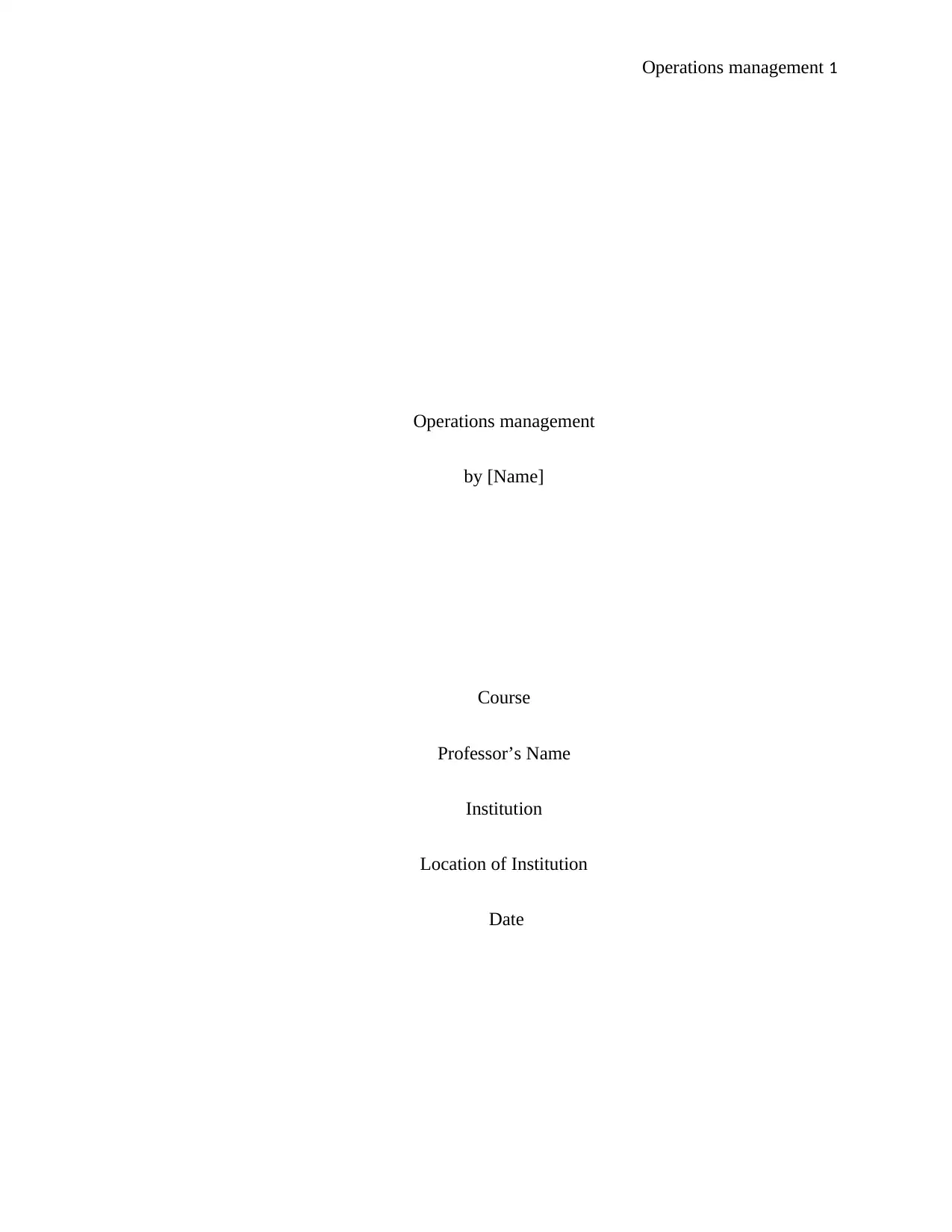
Operations management 1
Operations management
by [Name]
Course
Professor’s Name
Institution
Location of Institution
Date
Operations management
by [Name]
Course
Professor’s Name
Institution
Location of Institution
Date
Paraphrase This Document
Need a fresh take? Get an instant paraphrase of this document with our AI Paraphraser
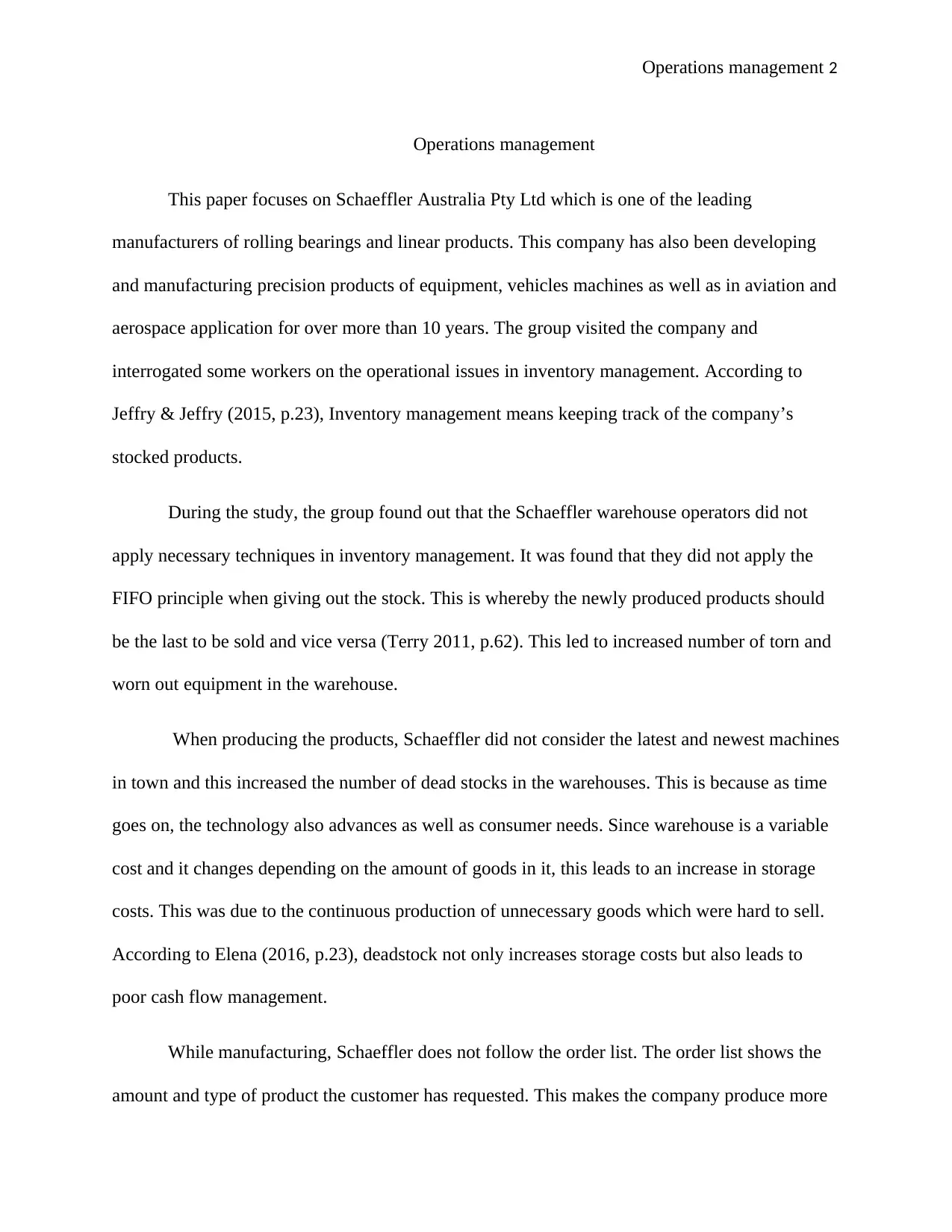
Operations management 2
Operations management
This paper focuses on Schaeffler Australia Pty Ltd which is one of the leading
manufacturers of rolling bearings and linear products. This company has also been developing
and manufacturing precision products of equipment, vehicles machines as well as in aviation and
aerospace application for over more than 10 years. The group visited the company and
interrogated some workers on the operational issues in inventory management. According to
Jeffry & Jeffry (2015, p.23), Inventory management means keeping track of the company’s
stocked products.
During the study, the group found out that the Schaeffler warehouse operators did not
apply necessary techniques in inventory management. It was found that they did not apply the
FIFO principle when giving out the stock. This is whereby the newly produced products should
be the last to be sold and vice versa (Terry 2011, p.62). This led to increased number of torn and
worn out equipment in the warehouse.
When producing the products, Schaeffler did not consider the latest and newest machines
in town and this increased the number of dead stocks in the warehouses. This is because as time
goes on, the technology also advances as well as consumer needs. Since warehouse is a variable
cost and it changes depending on the amount of goods in it, this leads to an increase in storage
costs. This was due to the continuous production of unnecessary goods which were hard to sell.
According to Elena (2016, p.23), deadstock not only increases storage costs but also leads to
poor cash flow management.
While manufacturing, Schaeffler does not follow the order list. The order list shows the
amount and type of product the customer has requested. This makes the company produce more
Operations management
This paper focuses on Schaeffler Australia Pty Ltd which is one of the leading
manufacturers of rolling bearings and linear products. This company has also been developing
and manufacturing precision products of equipment, vehicles machines as well as in aviation and
aerospace application for over more than 10 years. The group visited the company and
interrogated some workers on the operational issues in inventory management. According to
Jeffry & Jeffry (2015, p.23), Inventory management means keeping track of the company’s
stocked products.
During the study, the group found out that the Schaeffler warehouse operators did not
apply necessary techniques in inventory management. It was found that they did not apply the
FIFO principle when giving out the stock. This is whereby the newly produced products should
be the last to be sold and vice versa (Terry 2011, p.62). This led to increased number of torn and
worn out equipment in the warehouse.
When producing the products, Schaeffler did not consider the latest and newest machines
in town and this increased the number of dead stocks in the warehouses. This is because as time
goes on, the technology also advances as well as consumer needs. Since warehouse is a variable
cost and it changes depending on the amount of goods in it, this leads to an increase in storage
costs. This was due to the continuous production of unnecessary goods which were hard to sell.
According to Elena (2016, p.23), deadstock not only increases storage costs but also leads to
poor cash flow management.
While manufacturing, Schaeffler does not follow the order list. The order list shows the
amount and type of product the customer has requested. This makes the company produce more
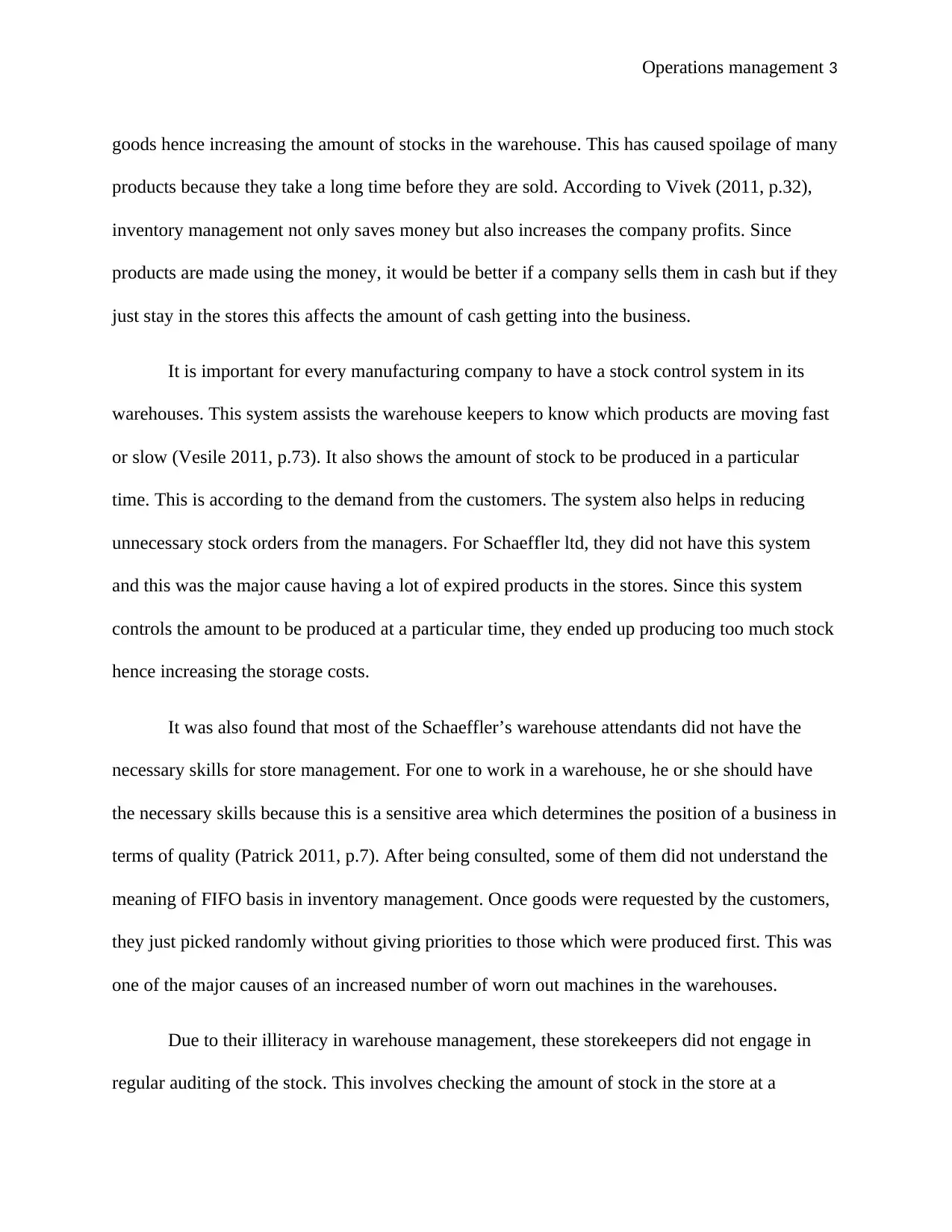
Operations management 3
goods hence increasing the amount of stocks in the warehouse. This has caused spoilage of many
products because they take a long time before they are sold. According to Vivek (2011, p.32),
inventory management not only saves money but also increases the company profits. Since
products are made using the money, it would be better if a company sells them in cash but if they
just stay in the stores this affects the amount of cash getting into the business.
It is important for every manufacturing company to have a stock control system in its
warehouses. This system assists the warehouse keepers to know which products are moving fast
or slow (Vesile 2011, p.73). It also shows the amount of stock to be produced in a particular
time. This is according to the demand from the customers. The system also helps in reducing
unnecessary stock orders from the managers. For Schaeffler ltd, they did not have this system
and this was the major cause having a lot of expired products in the stores. Since this system
controls the amount to be produced at a particular time, they ended up producing too much stock
hence increasing the storage costs.
It was also found that most of the Schaeffler’s warehouse attendants did not have the
necessary skills for store management. For one to work in a warehouse, he or she should have
the necessary skills because this is a sensitive area which determines the position of a business in
terms of quality (Patrick 2011, p.7). After being consulted, some of them did not understand the
meaning of FIFO basis in inventory management. Once goods were requested by the customers,
they just picked randomly without giving priorities to those which were produced first. This was
one of the major causes of an increased number of worn out machines in the warehouses.
Due to their illiteracy in warehouse management, these storekeepers did not engage in
regular auditing of the stock. This involves checking the amount of stock in the store at a
goods hence increasing the amount of stocks in the warehouse. This has caused spoilage of many
products because they take a long time before they are sold. According to Vivek (2011, p.32),
inventory management not only saves money but also increases the company profits. Since
products are made using the money, it would be better if a company sells them in cash but if they
just stay in the stores this affects the amount of cash getting into the business.
It is important for every manufacturing company to have a stock control system in its
warehouses. This system assists the warehouse keepers to know which products are moving fast
or slow (Vesile 2011, p.73). It also shows the amount of stock to be produced in a particular
time. This is according to the demand from the customers. The system also helps in reducing
unnecessary stock orders from the managers. For Schaeffler ltd, they did not have this system
and this was the major cause having a lot of expired products in the stores. Since this system
controls the amount to be produced at a particular time, they ended up producing too much stock
hence increasing the storage costs.
It was also found that most of the Schaeffler’s warehouse attendants did not have the
necessary skills for store management. For one to work in a warehouse, he or she should have
the necessary skills because this is a sensitive area which determines the position of a business in
terms of quality (Patrick 2011, p.7). After being consulted, some of them did not understand the
meaning of FIFO basis in inventory management. Once goods were requested by the customers,
they just picked randomly without giving priorities to those which were produced first. This was
one of the major causes of an increased number of worn out machines in the warehouses.
Due to their illiteracy in warehouse management, these storekeepers did not engage in
regular auditing of the stock. This involves checking the amount of stock in the store at a
⊘ This is a preview!⊘
Do you want full access?
Subscribe today to unlock all pages.

Trusted by 1+ million students worldwide

Operations management 4
particular time and comparing with what was sold in order to know the number of sales made
(Patrick 2014, p.11) This can either be done through physical counting or cycle. Physical
counting is mostly done at the end of the year for accounting purposes. On the other hand, cycle
counting is done daily weekly or even monthly. Schaeffler did not do any of the two regular
auditings and this lead to mismanagement of inventory.
The warehouse managers were asked if they have set levels of the amount of stock to be
in the store all the time and confirmed that there are no limits and therefore one can request for
stocks any time. These levels ensure that the company does not keep excess stock which can lead
to expiry products and also there are zero stocks in the store (Patrick & Praffula 2012, p.103).
Without these levels, Schaeffler ended up making unnecessary stock orders which increased the
number of stocks in the warehouse. Most of the customers ended up being disappointed
whenever they visited the company to collect equipment and machines.
The research also showed that the workers in those warehouses were rude and did not
consider having a good relationship with the suppliers. Schaeffler had various suppliers since no
one could deliver all the equipment required to produce a particular machine. Most of these
suppliers did not supply on time what was requested hence causing delays to their customers.
Some of them also supplied fake equipment and others did not meet the quantity required. The
warehouse managers were not only rude but didn’t communicate well with their suppliers. They
were always not aware of the time the company expects a sales increase for them to double their
supplies. This made them supply little or no supplies in most times. According to Shankar (2014,
p.25), maintaining good work relationship is important for it helps the company improve on its
efficiency.
particular time and comparing with what was sold in order to know the number of sales made
(Patrick 2014, p.11) This can either be done through physical counting or cycle. Physical
counting is mostly done at the end of the year for accounting purposes. On the other hand, cycle
counting is done daily weekly or even monthly. Schaeffler did not do any of the two regular
auditings and this lead to mismanagement of inventory.
The warehouse managers were asked if they have set levels of the amount of stock to be
in the store all the time and confirmed that there are no limits and therefore one can request for
stocks any time. These levels ensure that the company does not keep excess stock which can lead
to expiry products and also there are zero stocks in the store (Patrick & Praffula 2012, p.103).
Without these levels, Schaeffler ended up making unnecessary stock orders which increased the
number of stocks in the warehouse. Most of the customers ended up being disappointed
whenever they visited the company to collect equipment and machines.
The research also showed that the workers in those warehouses were rude and did not
consider having a good relationship with the suppliers. Schaeffler had various suppliers since no
one could deliver all the equipment required to produce a particular machine. Most of these
suppliers did not supply on time what was requested hence causing delays to their customers.
Some of them also supplied fake equipment and others did not meet the quantity required. The
warehouse managers were not only rude but didn’t communicate well with their suppliers. They
were always not aware of the time the company expects a sales increase for them to double their
supplies. This made them supply little or no supplies in most times. According to Shankar (2014,
p.25), maintaining good work relationship is important for it helps the company improve on its
efficiency.
Paraphrase This Document
Need a fresh take? Get an instant paraphrase of this document with our AI Paraphraser
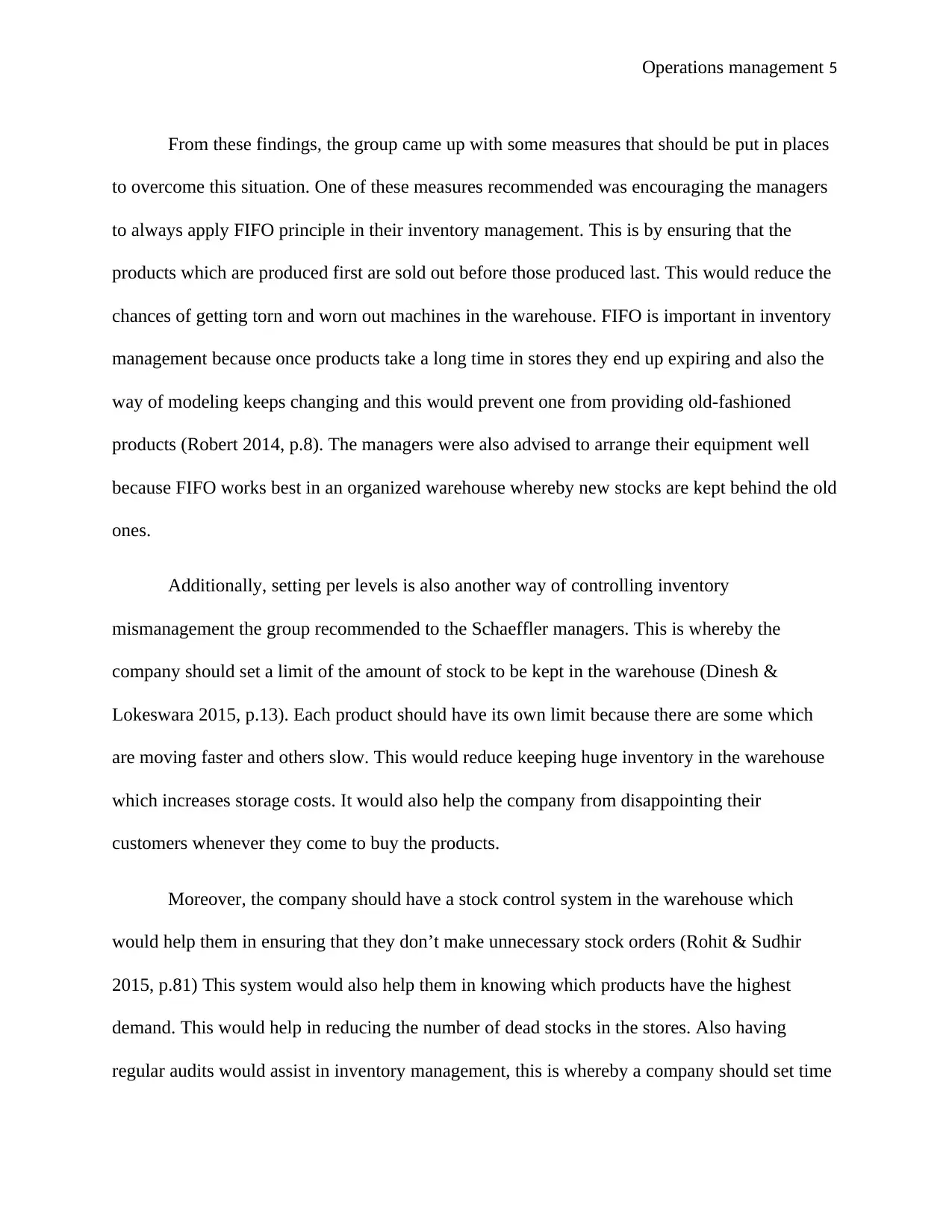
Operations management 5
From these findings, the group came up with some measures that should be put in places
to overcome this situation. One of these measures recommended was encouraging the managers
to always apply FIFO principle in their inventory management. This is by ensuring that the
products which are produced first are sold out before those produced last. This would reduce the
chances of getting torn and worn out machines in the warehouse. FIFO is important in inventory
management because once products take a long time in stores they end up expiring and also the
way of modeling keeps changing and this would prevent one from providing old-fashioned
products (Robert 2014, p.8). The managers were also advised to arrange their equipment well
because FIFO works best in an organized warehouse whereby new stocks are kept behind the old
ones.
Additionally, setting per levels is also another way of controlling inventory
mismanagement the group recommended to the Schaeffler managers. This is whereby the
company should set a limit of the amount of stock to be kept in the warehouse (Dinesh &
Lokeswara 2015, p.13). Each product should have its own limit because there are some which
are moving faster and others slow. This would reduce keeping huge inventory in the warehouse
which increases storage costs. It would also help the company from disappointing their
customers whenever they come to buy the products.
Moreover, the company should have a stock control system in the warehouse which
would help them in ensuring that they don’t make unnecessary stock orders (Rohit & Sudhir
2015, p.81) This system would also help them in knowing which products have the highest
demand. This would help in reducing the number of dead stocks in the stores. Also having
regular audits would assist in inventory management, this is whereby a company should set time
From these findings, the group came up with some measures that should be put in places
to overcome this situation. One of these measures recommended was encouraging the managers
to always apply FIFO principle in their inventory management. This is by ensuring that the
products which are produced first are sold out before those produced last. This would reduce the
chances of getting torn and worn out machines in the warehouse. FIFO is important in inventory
management because once products take a long time in stores they end up expiring and also the
way of modeling keeps changing and this would prevent one from providing old-fashioned
products (Robert 2014, p.8). The managers were also advised to arrange their equipment well
because FIFO works best in an organized warehouse whereby new stocks are kept behind the old
ones.
Additionally, setting per levels is also another way of controlling inventory
mismanagement the group recommended to the Schaeffler managers. This is whereby the
company should set a limit of the amount of stock to be kept in the warehouse (Dinesh &
Lokeswara 2015, p.13). Each product should have its own limit because there are some which
are moving faster and others slow. This would reduce keeping huge inventory in the warehouse
which increases storage costs. It would also help the company from disappointing their
customers whenever they come to buy the products.
Moreover, the company should have a stock control system in the warehouse which
would help them in ensuring that they don’t make unnecessary stock orders (Rohit & Sudhir
2015, p.81) This system would also help them in knowing which products have the highest
demand. This would help in reducing the number of dead stocks in the stores. Also having
regular audits would assist in inventory management, this is whereby a company should set time

Operations management 6
to identify the level of stocks in their stores. This can be daily, weekly or even monthly. Regular
auditing helps in knowing whether the company is making huge sales or not. This process also
helps in knowing products which took a long time in the store before being sold. Also, making
good forecasting would enable in reducing inventory mismanagement. This involves being able
to determine where particular products would have high or low demands in the future. Making
good forecasts prevents one from making unnecessary stock orders.
From the findings and recommendations, one can notice that inventory management is
the key determinant to the company’s sales profile and the company should follow the necessary
procedures of inventory management. However, there are some of the things which can lead to
inventory mismanagement. One of them id failing to apply FIFO principle in inventory
management which prevents an increase of expiry goods in the warehouse. Also, lack of stock
control machines in the warehouse can lead to unnecessary stock orders. Moreover, poor
relationship between workers and suppliers can lead to a supply of fake products or little supplies
which makes the company not meet its customers’ expectations. These ways can lead to
increased storage costs, expired good and also a high number of dead stock. There are some of
the measures which should be put in place to ensure proper inventory management. One is that
the company should always make sure that the old stocks are sold first before the new products.
Also, there should be systems in the warehouses which helps the workers to know which stock is
moving faster. This would decrease the level of dead stocks in the stores.
to identify the level of stocks in their stores. This can be daily, weekly or even monthly. Regular
auditing helps in knowing whether the company is making huge sales or not. This process also
helps in knowing products which took a long time in the store before being sold. Also, making
good forecasting would enable in reducing inventory mismanagement. This involves being able
to determine where particular products would have high or low demands in the future. Making
good forecasts prevents one from making unnecessary stock orders.
From the findings and recommendations, one can notice that inventory management is
the key determinant to the company’s sales profile and the company should follow the necessary
procedures of inventory management. However, there are some of the things which can lead to
inventory mismanagement. One of them id failing to apply FIFO principle in inventory
management which prevents an increase of expiry goods in the warehouse. Also, lack of stock
control machines in the warehouse can lead to unnecessary stock orders. Moreover, poor
relationship between workers and suppliers can lead to a supply of fake products or little supplies
which makes the company not meet its customers’ expectations. These ways can lead to
increased storage costs, expired good and also a high number of dead stock. There are some of
the measures which should be put in place to ensure proper inventory management. One is that
the company should always make sure that the old stocks are sold first before the new products.
Also, there should be systems in the warehouses which helps the workers to know which stock is
moving faster. This would decrease the level of dead stocks in the stores.
⊘ This is a preview!⊘
Do you want full access?
Subscribe today to unlock all pages.

Trusted by 1+ million students worldwide

Operations management 7
References
Dinesh, D & Lokeswara, YC 2015, Challenges with Multi-
Dimensional Inventory Classifications and Optimization, Asian Social Science, VOL.11, NO.4,
PP. 12-16
Elena, LG 2016, The Need for Implementation of the Inventory Management System at the
Modern Enterprises, Journal of Organizational Culture, Communications and Conflict, VOL.20,
NO.14, PP. 20-25
Jeffry, M & Jeffry, S 2015, An Inventory Letter from Carter's to Kohl's-What Could Go Wrong?
Journal of Critical Incidents, PP. 20-26
Patrick, B 2011, From the S&OP Trenches: Quick-Hit Tips to Reduce Inventory, the Journal of
Business Forecasting, VOL.30, NO.3, PP. 5-12
Patrick, L & Praffula, J 2012, Continuously Increasing Price in a Gradual
Usage Inventory Cycle: An Optimal Strategy for Coordinating Production with Pricing for a
Supply Chain, Academy of Information and Management Sciences Journal, VOL.15, NO.1, PP.
99-111
Patrick, L 2014, Coordinating Pricing and Inventory Purchasing Decisions of a Supply Chain for
an E-Trailer in Face of Quantity Discounts, Academy of Information and Management Sciences
Journal, VOL.17, NO.2, PP. 10-15
Robert, AD 2014, Maximize ERP Value with Inventory Optimization, the Journal of Business
Forecasting, VOL.33, NO.1, PP. 4-10
References
Dinesh, D & Lokeswara, YC 2015, Challenges with Multi-
Dimensional Inventory Classifications and Optimization, Asian Social Science, VOL.11, NO.4,
PP. 12-16
Elena, LG 2016, The Need for Implementation of the Inventory Management System at the
Modern Enterprises, Journal of Organizational Culture, Communications and Conflict, VOL.20,
NO.14, PP. 20-25
Jeffry, M & Jeffry, S 2015, An Inventory Letter from Carter's to Kohl's-What Could Go Wrong?
Journal of Critical Incidents, PP. 20-26
Patrick, B 2011, From the S&OP Trenches: Quick-Hit Tips to Reduce Inventory, the Journal of
Business Forecasting, VOL.30, NO.3, PP. 5-12
Patrick, L & Praffula, J 2012, Continuously Increasing Price in a Gradual
Usage Inventory Cycle: An Optimal Strategy for Coordinating Production with Pricing for a
Supply Chain, Academy of Information and Management Sciences Journal, VOL.15, NO.1, PP.
99-111
Patrick, L 2014, Coordinating Pricing and Inventory Purchasing Decisions of a Supply Chain for
an E-Trailer in Face of Quantity Discounts, Academy of Information and Management Sciences
Journal, VOL.17, NO.2, PP. 10-15
Robert, AD 2014, Maximize ERP Value with Inventory Optimization, the Journal of Business
Forecasting, VOL.33, NO.1, PP. 4-10
Paraphrase This Document
Need a fresh take? Get an instant paraphrase of this document with our AI Paraphraser
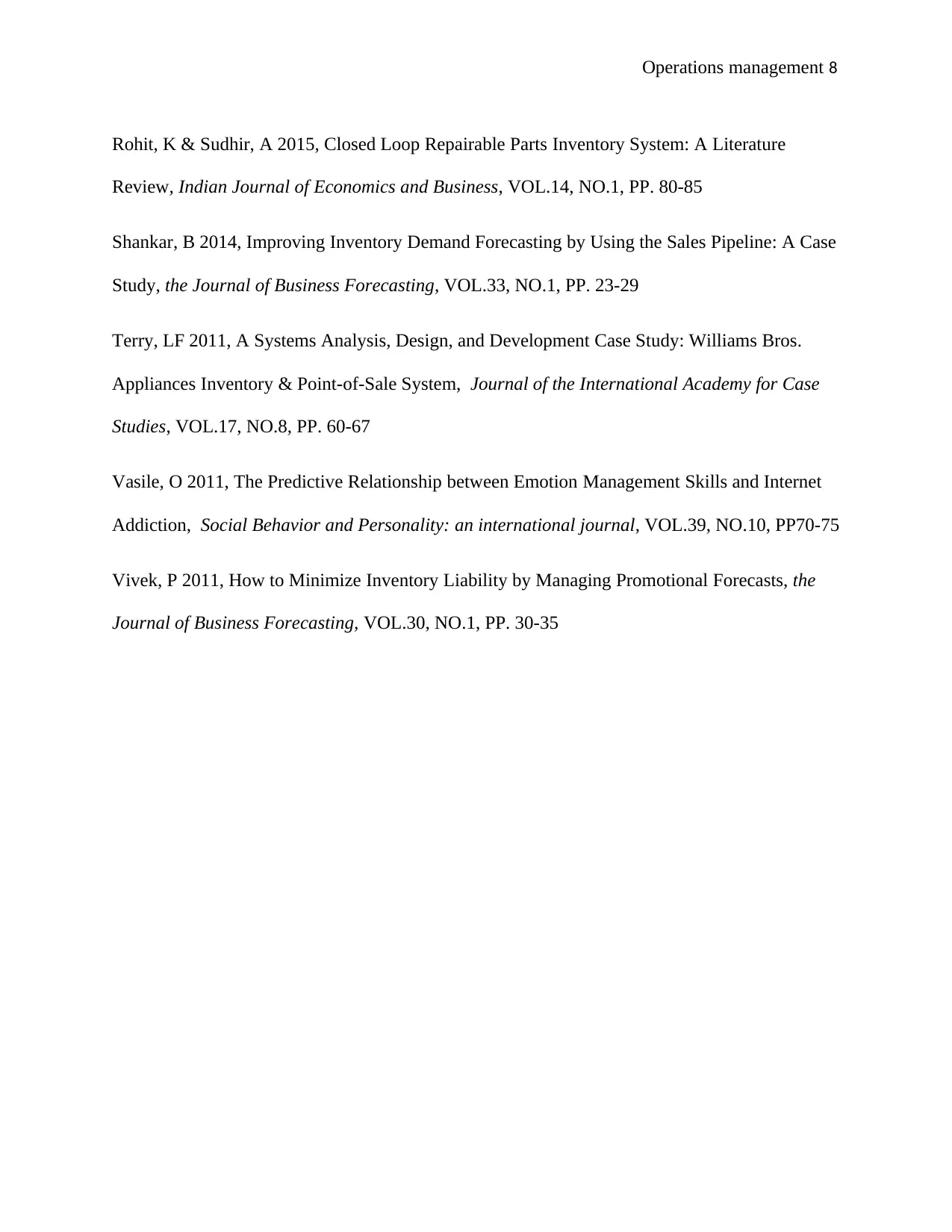
Operations management 8
Rohit, K & Sudhir, A 2015, Closed Loop Repairable Parts Inventory System: A Literature
Review, Indian Journal of Economics and Business, VOL.14, NO.1, PP. 80-85
Shankar, B 2014, Improving Inventory Demand Forecasting by Using the Sales Pipeline: A Case
Study, the Journal of Business Forecasting, VOL.33, NO.1, PP. 23-29
Terry, LF 2011, A Systems Analysis, Design, and Development Case Study: Williams Bros.
Appliances Inventory & Point-of-Sale System, Journal of the International Academy for Case
Studies, VOL.17, NO.8, PP. 60-67
Vasile, O 2011, The Predictive Relationship between Emotion Management Skills and Internet
Addiction, Social Behavior and Personality: an international journal, VOL.39, NO.10, PP70-75
Vivek, P 2011, How to Minimize Inventory Liability by Managing Promotional Forecasts, the
Journal of Business Forecasting, VOL.30, NO.1, PP. 30-35
Rohit, K & Sudhir, A 2015, Closed Loop Repairable Parts Inventory System: A Literature
Review, Indian Journal of Economics and Business, VOL.14, NO.1, PP. 80-85
Shankar, B 2014, Improving Inventory Demand Forecasting by Using the Sales Pipeline: A Case
Study, the Journal of Business Forecasting, VOL.33, NO.1, PP. 23-29
Terry, LF 2011, A Systems Analysis, Design, and Development Case Study: Williams Bros.
Appliances Inventory & Point-of-Sale System, Journal of the International Academy for Case
Studies, VOL.17, NO.8, PP. 60-67
Vasile, O 2011, The Predictive Relationship between Emotion Management Skills and Internet
Addiction, Social Behavior and Personality: an international journal, VOL.39, NO.10, PP70-75
Vivek, P 2011, How to Minimize Inventory Liability by Managing Promotional Forecasts, the
Journal of Business Forecasting, VOL.30, NO.1, PP. 30-35
1 out of 8
Related Documents
Your All-in-One AI-Powered Toolkit for Academic Success.
+13062052269
info@desklib.com
Available 24*7 on WhatsApp / Email
![[object Object]](/_next/static/media/star-bottom.7253800d.svg)
Unlock your academic potential
Copyright © 2020–2025 A2Z Services. All Rights Reserved. Developed and managed by ZUCOL.




